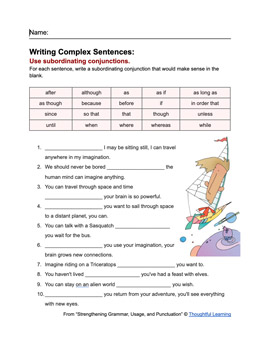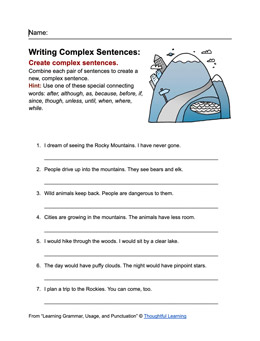
Fitting grammar instruction into your busy classroom can put you in a pickle. On the one hand, students need consistent practice and support with grammar and conventions. On the other hand, correctness is just one aspect of effective writing—students also need to develop other essential traits and write for authentic purposes.
How can you find the time?
One solution is to integrate grammar minilessons into your larger writing units. That way students receive practice and reinforcement without feeling overwhelmed, and you gain extra class time to devote to other skills.
The activities below demonstrate one way to sequence grammar instruction in your weekly ELA schedule.
Teaching Complex Sentences
Read aloud or paraphrase these 10–15 minute minilessons to teach students how to use complex sentences. (Get the lessons in a Google Doc.)
Day 1: Study Mentor Sentences
- This week we’re going to explore complex sentences. If the word complex scares you, don’t worry. A complex sentence is not complicated to read or write. You just need to know about some special connecting words and a common comma rule.
- To get started, let’s look at some examples of complex sentences. We’ll return to these sentences each day this week.
- (Display the sample sentences.) With a partner, read the examples out loud.
- When I remember Paw Paw now, I think of the pictures on Grandmother’s cabinet.
- Whenever Oriana felt strong emotion, her eyes changed from their usual ebony to true gold.
- If elephants disappeared, many tree species would suffer the consequences.
- The world must unite like never before if we want to save our remaining elephants.
- Answer these questions with your partner:
- What stands out to you about these sentences?
- What similarities do you notice in the first three?
- How is the last sentence different from the others?
- Great job! Would anyone be willing to share your group’s answers?
Day 2: Define the Concept
- (Display the same sample sentences as Day 1.)
- Yesterday, we discussed examples of complex sentences. Today, we’re going to define what makes them complex.
- (Play this video to define complex sentences.)
- So, you can turn two simple sentences into a complex sentence by adding a special connecting word, such as after, although, as, because, before, if, since, though, unless, until, when, where, and while.
- (Display or hand out this graphic.) The connecting words that create complex sentences are called subordinating conjunctions. These words signal important information to readers, such as time, cause/effect, and condition.
- Now it's your turn to connect simple sentences with subordinating conjunctions. (Share this activity.)

Download the PDF or copy the Google Doc.
Day 3: Combine and Create
- Yesterday, you learned how a complex sentence includes two simple sentences connected by a subordinating conjunction.
- Before you practice creating more complex sentences, take a moment to read this essay. Can you spot examples of complex sentences? What subordinating conjunction does each complex sentence include? (Point out how the complex sentences connect ideas and help the essay flow.)
- Good. Now let's practice combining two simple sentences into one complex sentence
- (Display these examples. Ask for volunteers to read them out loud.)
- Two simple sentences: Oriana felt strong emotion. Her eyes changed from their usual ebony to true gold.
- One complex sentence: Whenever Oriana felt strong emotion, her eyes changed from their usual ebony to true gold.
- Two simple sentences: We want to save our remaining elephants. The world must unite like never before.
- One complex sentence: The world must unite like never before if we want to save our remaining elephants.
- Notice that when the connecting word starts the sentence, a comma is needed to connect the two parts. No comma is needed when the clause with the connecting word starts in the middle of the sentence.
- You're now ready to create complex sentences. (Share this activity.) Make sure you bring the completed activity to class tomorrow.
Download the PDF or copy the Google Doc.
Day 4: Focus on Punctuation
- Yesterday, we combined short sentences into complex sentences. Today, we will focus on an important punctuation rule associated with complex sentences.
- Here's the rule: If the subordinating conjunction begins the sentence, place a comma after the first part. If it comes in the middle, leave out the comma.
- (Display the four sample sentences from earlier this week. Read them orally, including the commas. Ask students why the last sentence does not include a comma.)
- Please take out the sentence-combining activity you completed yesterday.
- Check each sentence for the comma rule. Do you follow it correctly?
- Now, find one sentence that begins with a connecting word. Swap the sentence parts: Move the connecting word and first part of the sentence to the end of the sentence. Then delete the comma. (Model this activity for students.)
- By experimenting with the order of your complex sentences, you can control the rhythm and flow of your writing.
Day 5: Imitate and Apply
- This week we’ve studied how to use complex sentences. Now it’s time to apply them to your own writing.
- One of the best ways to create interesting sentences is to imitate, or model, the pattern used by your favorite writers. Let’s try it out.
- Model these complex sentences by filling in the blanks. (Join students in this activity.)
- When I remember Paw Paw now, I think of the pictures on Grandmother’s cabinet.
- When I remember ___________ now, I think of ________________.
- If elephants disappeared, many tree species would suffer the consequences.
- If ____________ disappeared, ________________________.
- Who would like to share their sentences?
- Take out a piece of writing you are working on. Apply what you’ve learned about complex sentences to your own writing:
- Look for examples of complex sentences. How many do you find?
- Check your comma usage in each example.
- Find two simple sentences and combine them into a complex sentence.
- Great work!
Teaching Support
Consider this support as you implement the activities.
Grade Level
4–8
Learning Objectives
By completing these activities, students will . . .
- Recognize complex sentences.
- Use subordinating conjunctions to connect simple sentences.
- Insert commas after introductory elements.
- Write complex sentences to connect ideas and create flow.
Teaching Tips
- Adapt the teaching script to suit the needs of your students.
- If time permits, introduce the difference between dependent and independent clauses.
- Use a similar sequence for teaching other concepts, such as compound sentences.
- Follow best practices for teaching grammar.

